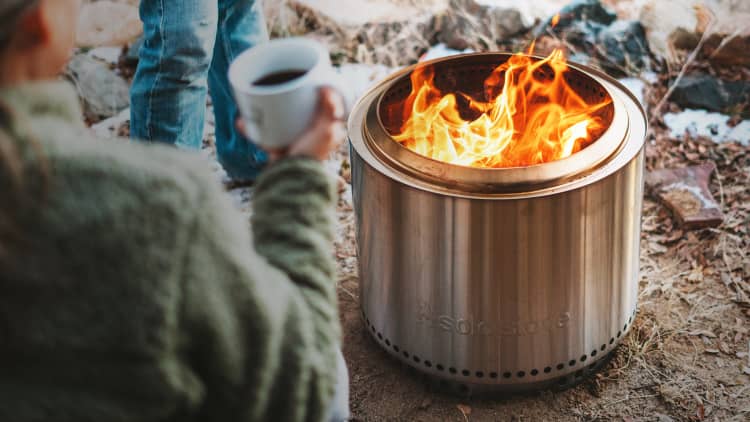This story is part of CNBC Make It’s Six-Figure Side Hustle series, where people with lucrative side hustles break down the routines and habits they’ve used to make money on top of their full-time jobs. Got a story to tell? Let us know! Email us at [email protected].
Six months ago, Tim Riegel bent over his computer, reviewed his monthly earnings statement and saw that his highly lucrative side hustle was making less money.
He was shocked — until he realized just how much inflation was impacting his business.
Riegel’s side hustle, Mozark Fire Pit Studio, was successful immediately upon launching in 2021. He started by sourcing, welding and selling 275-pound steel fire pits to his neighbors in Lamar, Missouri, a rural town of 4,000 people two hours south of Kansas City. Within six months, freight trucks were delivering his products to Etsy buyers across the U.S. and Canada.
The business brought in $50,000 in sales in just five months on the platform, according to documents reviewed by CNBC Make It.
Staring at his screen, Riegel, 60, noticed that his volume of orders was still high. But his profit margins were shrinking, because the cost of recyclable steel, gas and packaging supplies were climbing.
He’s far from alone. Between April 2021 and April 2023, everyday essentials like groceries, utilities and gas cost Americans 20%, according to a CNBC Make It analysis of consumer price index data.
Riegel’s side hustle is a mostly solo endeavor. He pays one contract worker $15 per hour to help load the massive fire pits into freight trucks, he says.
Tim Riegel
While keeping an eye on his competitors, Riegel raised his prices to get his margins back into the 35% to 40% range, he says. He added new features to his products — more color and customization options — to help justify the price increases for consumers.
Today, his fire pits cost an average of $950, up from $650 since fall 2022 — and in the last 12 months, Mozark has brought in $169,000 in sales.
If he’d waited any longer, the price jumps would have been higher, and customers could have bolted, Riegel says. His No. 1 lesson: Reevaluate your prices on a monthly basis, so you can gradually raise them instead of jolting your customers with larger, more sporadic increases.
Here, Riegel discusses his pricing strategy, the skills you need to start a side hustle like his and how he balances the time-consuming gig with his full-time job and personal life.
CNBC Make It: How do you decide on your side hustle’s pricing? Were you worried that raising your prices would scare away customers?
Riegel: In today’s climate, you have to really watch the costs — of everything from fuel to your supplies — to make sure paying yourself what you need to pay yourself.
It can get away from you, and the next thing you know, you’re watching your margins dwindle. If you’re not making a profit, it’s not worth spending the extra 40 hours per week.
I didn’t want to price myself out of the market, either. I’m constantly looking at my competitors — not just on Etsy, but throughout the U.S. — to see who’s making similar types of pits, and their pricing. I make sure to stay within that ballpark.
As for consumers, I’ve been able to keep prices steadier by reducing my freight costs, which I’m able to do now that my volume is so much higher.
Do you need cash or specific skills to start a fire pit side hustle?
You need cash, at least to start trying. I’m sure people can replicate it, if they have similar skills — like welding, creativity and the know-how to source the steel.
I use Facebook Marketplace to get a lot of supplies. Some things would be harder to copy: I have nearly two decades of welding experience, and not everybody can do patina, color or add the customizations that I can do design-wise.
Mozark fire pits are “meant to last a long time, a lifetime,” Riegel says.
Tim Riegel
If someone places an order on Esty, they might say, “Hey, I want a fourth handle,” or “I want my lid to look like this,” I can adjust accordingly to meet their needs.
Knock on wood, but I’ve never gotten less than a five-star review on Etsy. I think that’s also because I spend three hours per week talking to my customers via text. I send them photos of their fire pits before I ship it, and I contact them after they’ve received it to make sure they’re happy.
You said this side hustle adds at least 40 hours to your full-time workweek. How do you balance that with your personal life?
In the last year, I started working at as a general manager in a sheltered workshop called Lamar Enterprises. That, combined with my past experience restoring cars and working for a furniture company, has helped me get really good at predicting lead times.
My side hustle production schedule is more or less scheduled around my private life. I know how long it’s going to source everything and make it, no matter what variations the person adds. I can be flexible, and as I schedule my pits, I also schedule date nights with my wife.
It helps to have a good partner or a spouse that understands. It’s a lot of work. But the thing that keeps me going is I just really like doing it.
DON’T MISS: Want to be smarter and more successful with your money, work & life? Sign up for our new newsletter!
Take your business to the next level: Register for CNBC’s free Small Business Playbook virtual event on August 2 at 1 p.m. ET to learn from premier experts and entrepreneurs how you can beat inflation, hire top talent and get access to capital.
Check out more from Six-Figure Side Hustle:


